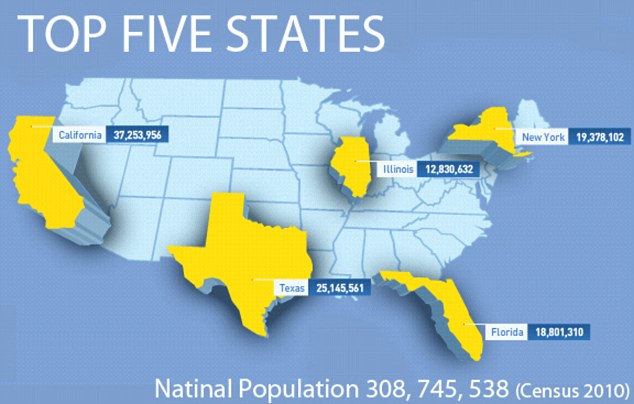译言网chunfengqiushui编译/美国大量的乡村正日益空虚化,很多社区正变成鬼镇,因为美国农村人口只占全国总人口的16%。
2010年的人口普查结果显示,到2050年这些区域将随着工商业的溃退和学校的关闭而渐渐缩小到实际上没有。
戏剧般的人口内挤是一个世纪城市化过程的结果。一百年前,亦即1910年,美国农村人口占总人口的72%。
(下面这幅人口分布图,亮点表示城市区,而黑暗部分表示农村)
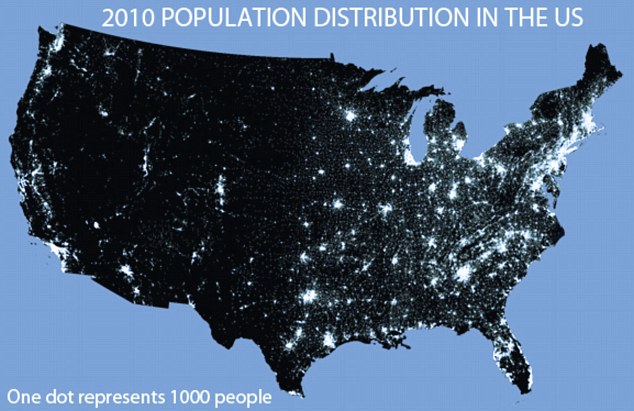
Blackout: This official graphic shows dominant U.S. urban areas, marked in white, while large swathes of rural areas are becoming darker as people move away
1950年,美国的乡村人口仍占很大一部分,当时正处于二战后的经济扩张和婴儿潮时期。然而一旦繁忙的区域被抛弃,鬼镇就形成了。以南达科他州为例,景色优美的小镇打算只卖799000美元,因为现今只有8人住在这里。
农村人口比例在过去十年里下降至16%。2000年,农村人口还占全国总人口的20%。随着经济危机的发生,这一比例估计还会下滑。但是美国的城市却蓬勃发展并继续吞并城郊的社区,形成贯穿于马萨诸塞州波士顿、纽约市、宾夕法尼亚州费城、马里兰州巴尔的摩和哥伦比亚特区华盛顿之间的实际上的大城市。
(美国人口最多的5个州:加州、德州、纽约州、佛罗里达州和伊利诺伊州)
“随着这个国家广大地区的日益空虚化,一些最偏远的农村地区面临着一场艰难费时的战斗。”哥伦比亚特区华盛顿人口参考局(Population Reference Bureau,PRB)副主席马克·马瑟(Mark Mather)说,“很多农村地区不能吸引工人,因为那里没有工作;工商企业不会迁往那里,因为那里没有足够的合格工人。因此它们呈下螺旋形变化。”
到2050年,美国总人口将由3.09亿增加到4亿,但在这一过程中农村的人口估计还会进一步减少,许多人会迁往城市或城郊。
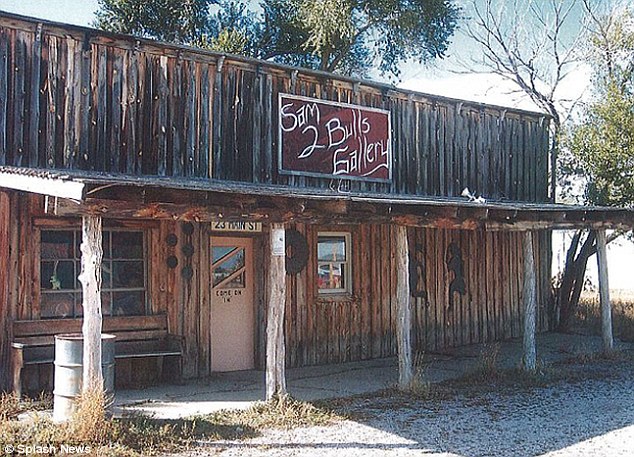
Ghost town: Scenic South Dakota was once a thriving train stop, complete with a saloon, and two jails, but now all the businesses are closed and eight people live there
2010年人口普查发现,城市长了11%。事实上增长最快的10个地方都是已经成为日益扩张的大都市区郊区的小城市,大部分在加州、亚利桑那州和德州。
总的说来,美国城郊的人口已增至破纪录的51%。尽管东北和中西部地区的大城市的人口自2000年以来因为经济衰退而急剧下降,但美国城市人口比从3%增至三分之一。这一数据可通过内华达大学拉斯维加斯分校社会学教授罗伯特·朗(Robert Lang)和布鲁金斯学会人口统计学家威廉·H·弗雷(William H. Frey)的计算得以补充。
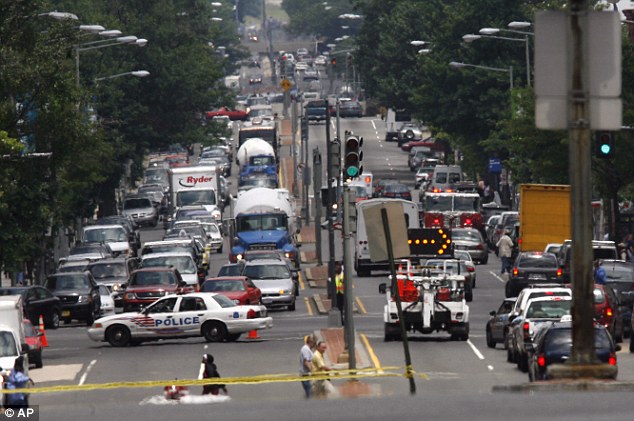
Packed: Washington D.C. will become an even bigger megalopolis, one of several that dominates the north-east of the U.S.
人口普查中的“农村”通常被定义为非大都市区、人口少于5万的地区。“这些新的模式显示边界随着区域的扩展超过政府的定义而日益变得模糊。”弗雷先生说,“人们喜欢在较小但靠近工作和大城市便利设施(如购物、文化活动、大型体育赛事和娱乐集会)的城镇有自己供得起的住房。”
人口统计学家说,像美国中部的大平原地区、东部的阿巴拉契亚地区、南部和德州的一些地区可能面临最明显的人口衰减。这些地方在过去十年里遭受着最严重的损失,因为年轻人已经离开,而留在那里的人日益老去。
农村地区很难吸引新居民而且难以获得联邦和政府的财政支持。达美航空公司(Delta Air Lines)最近宣布,它将终止24个小机场的航空服务,其中一些就位于大平原区。美国邮政业正准备关掉全国大部分农村地区数千分支机构。
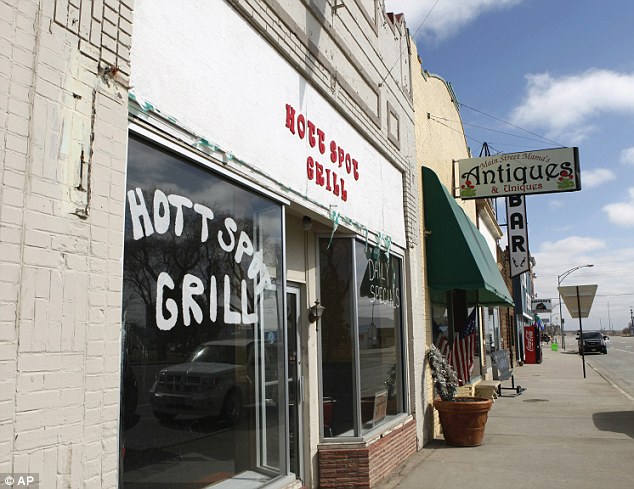
Deserted: The closed Hott Spot Grill, along with a couple of other businesses that remain on Main Street is seen in the centre of Hugo, Colorado
许多农村地区,特别是大平原地区的农村,人口自上个世纪三十年代以来稳步下降,而且接下来的的十年里还有继续下降的趋势。
仍在苦苦挣扎的农村地区之一是阿巴拉契亚地区的西弗吉尼亚大片地区。几个州的县在过去十年里因为伐木和采矿业的衰落而人口骤降。
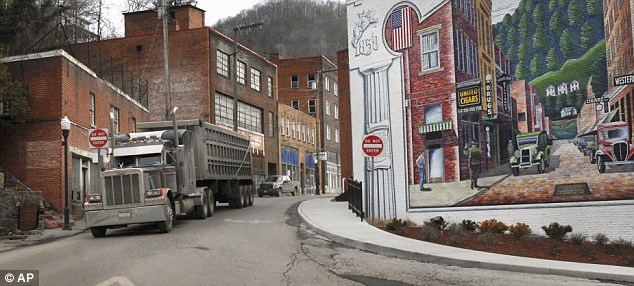
Migrating: A coal truck drives out of downtown Welch, West Virginia, which is one of the worst hit states for losing its population
美国人口最多的15大城市
1、纽约州纽约市,8175133人
2、加州洛杉矶,3792621人
3、伊利诺伊州芝加哥,2695598人
4、德州休斯顿,2099451人
5、宾夕法尼亚州费城,1526006人
6、亚利桑那州凤凰城,1445632人
7、德州圣安东尼奥,1327407人
8、加州圣迭戈,1307402人
9、德州达拉斯,1197816人
10、加州圣何塞,945942人
11、佛罗里达州杰克逊维尔,821784
12、印第安纳州印第安纳波利斯,820445人
13、加州旧金山,805235人
14、德州奥斯汀,790390人
15、俄亥俄州哥伦布,784033
Ghost towns on the increase as rural America accounts for just 16% of population
-Migration will form a virtual mega-city stretching through Boston, New York City, Philadelphia, Pennsylvania, Baltimore, Maryland and ending in the capital Washington D.C.
-In 1910 72% of Americans lived in rural areas
By DAILY MAIL REPORTER
Last updated at 4:42 PM on 28th July 2011
Vast swathes of the U.S. countryside are emptying and communities becoming ghost towns as rural America now only accounts for just 16 per cent of the population.
The 2010 census results suggest that by 2050 many of these areas could shrink to virtually nothing as businesses collapse and schools close.
This dramatic population implosion is the culmination of a century of migration to cities, as in 1910 the share of rural America was at 72 per cent.
In 1950 the countryside remained home to a majority of Americans, amid post-World War II economic expansion and the baby boom.
However, once busy areas have been abandoned, in South Dakota for example, the town of Scenic is up for sale for $799,000 as today just eight people live there.
Overall the share of people in rural areas over the past decade fell to 16 percent, passing the previous low of 20 percent in 2000, and is expected to drop further because of the economic crisis.
But in contrast American cities are booming and will continue to swallow suburban communities, producing a virtual mega-city stretching through Boston, Massachusetts, through New York City, Philadelphia, Pennsylvania, Baltimore, Maryland and ending in the capital Washington, D.C.
‘Some of the most isolated rural areas face a major uphill battle, with a broad area of the country emptying out,’ said Mark Mather, associate vice president of the Population Reference Bureau, a research group in Washington, D.C.
‘Many rural areas can’t attract workers because there aren’t any jobs, and businesses won’t relocate there because there aren’t enough qualified workers. So they are caught in a downward spiral.’
The rural share is expected to drop further as the U.S. population balloons from 309 million to 400 million by 2050, leading even more people to crowd cities and suburbs and fill in the land around them.
In 2010, the census found cities grew overall by 11 percent with the biggest gains in suburbs or small- or medium-sized cities.
In fact, of the 10 fastest-growing places, all were small cities incorporated into the suburbs of expanding metro areas, mostly in California, Arizona and Texas.
In all, the share of Americans living in suburbs has climbed to an all-time high of 51 percent.
Despite sharp declines in big cities in the Northeast and Midwest since 2000 due to the recession, U.S. cities increased their share by 3 percent to a third.
The data was supplemented with calculations by Robert Lang, a sociology professor at the University of Nevada-Las Vegas, and William H. Frey, a demographer at the Brookings Institution.
In the census ‘rural’ is generally defined as non-metropolitan areas with fewer than 50,000 people.
‘These new patterns suggest that there will be a blurring of boundaries as regions expand well beyond official government-defined definitions,’ Mr Frey said.
‘People like to have it all – affordable housing in a smaller-town setting but in close proximity to jobs and big-city amenities such as specialised shopping, cultural events and major sports and entertainment venues.’
Areas areas like the Great Plains in the central U.S. and Appalachia in the East, along with parts of the South and Texas, could face the most significant population declines, demographers say.
These places suffered some of the biggest losses over the past decade as young adults left and the people who stayed got older, moving past childbearing years.
Rural towns are scrambling to attract new residents and stave off heavy funding cuts from financially strapped federal and state governments.
Delta Air Lines recently announced it would end flight service to 24 small airports, several of them in the Great Plains, and the U.S.
The U.S. Postal Service is mulling plans to close thousands of branches in mostly rural areas of the country.
Many rural areas, the central Great Plains in particular, have been steadily losing population since the 1930s with few signs of the trend slowing in coming decades.
Among the struggling rural areas are vast stretches of West Virginia in Appalachia. Several of the state’s counties over the past decade have lost large chunks of their population following the collapse of logging and coal-mining industries.
Largest U.S. cities with populations
1 New York, New York 8,175,133
2 Los Angeles, California 3,792,621
3 Chicago, Illinois 2,695,598
4 Houston, Texas 2,099,451
5 Philadelphia, Pennsylvania 1,526,006
6 Phoenix Arizona, 1,445,632
7 San Antonio, Texas 1,327,407
8 San Diego, California 1,307,402
9 Dallas, Texas 1,197,816
10 San Jose, California 945,942
11 Jacksonville, Florida 821,784
12 Indianapolis, Indiana 820,445
13 San Francisco, California 805,235
14 Austin Texas, 790,390
15 Columbus, Ohio 787,033
http://www.dailymail.co.uk/news/article-2019771/Ghost-towns-increase-rural-America-accounts-just-16-population.html

